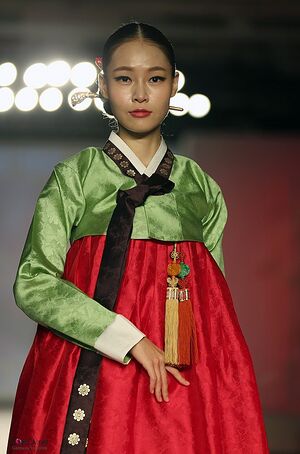Mettubok: Difference between revisions
Started on the page for my nation's traditional dress. |
mNo edit summary |
||
| (2 intermediate revisions by 2 users not shown) | |||
| Line 1: | Line 1: | ||
[[Category:IXWB]] | |||
[[File:MettubokF.jpg|thumb|A woman wearing modern Mettubok.]] | [[File:MettubokF.jpg|thumb|A woman wearing modern Mettubok.]] | ||
'''Mettubok''' (literally "mountain clothes") is the traditional dress of [[Metzetta]]. The basic structure of mettubok consists of the ''jeogori'' jacket, ''baji'' pants, ''chima'' skirt, and the ''po'' coat; it was designed to facilitate easy movement. Metzettans wear the mettubok today for formal or semi-formal occasions and events such as festivals, celebrations, and ceremonies including weddings. | '''Mettubok''' (literally "mountain clothes") is the traditional dress of [[Metzetta]]. The basic structure of mettubok consists of the ''jeogori'' jacket, ''baji'' pants, ''chima'' skirt, and the ''po'' coat; it was designed to facilitate easy movement. Metzettans wear the mettubok today for formal or semi-formal occasions and events such as festivals, celebrations, and ceremonies including weddings. | ||
== History == | == History == | ||
== Construction and design == | == Construction and design == | ||
=== Male === | === Male === | ||
Men's mettubok consists of jeogori and baji. Po may be added for additional warmth. | Men's mettubok consists of jeogori and baji. Po may be added for additional warmth. | ||
=== Female === | === Female === | ||
Women's mettubok consists of jeogori and chima. Po may be added for additional warmth. | Women's mettubok consists of jeogori and chima. Po may be added for additional warmth. | ||
=== Children === | === Children === | ||
== Occasions == | == Occasions == | ||
Mettubok is classified according to its purposes: everyday dress, ceremonial dress, and special dress. Ceremonial dresses are worn on formal occasions, including weddings and funerals. Special dresses are made for shamans and officials. Mettubok is worn on Metzettan holidays such as Chusu, Saehae and Gaehwa. | Mettubok is classified according to its purposes: everyday dress, ceremonial dress, and special dress. Ceremonial dresses are worn on formal occasions, including weddings and funerals. Special dresses are made for shamans and officials. Mettubok is worn on Metzettan holidays such as Chusu, Saehae and Gaehwa. | ||
| Line 20: | Line 15: | ||
In 2000, [[Pomewa Joya|Empress Joya]] instituted Mettubok Day to encourage Metzettans to continue honouring their fine clothing tradition. | In 2000, [[Pomewa Joya|Empress Joya]] instituted Mettubok Day to encourage Metzettans to continue honouring their fine clothing tradition. | ||
== Social Status == | == Social Status == | ||
=== Clothes === | === Clothes === | ||
=== Accessories === | === Accessories === | ||
== Modern Times == | == Modern Times == | ||
[[File:MettubokM.jpg|thumb|A man wearing modern Mettubok.]] | [[File:MettubokM.jpg|thumb|A man wearing modern Mettubok.]] | ||
Although mettubok is a traditional costume, it has been re-popularized in modern fashion. | Although mettubok is a traditional costume, it has been re-popularized in modern fashion. | ||
[[Category:Metzetta]] | [[Category:Metzetta]] | ||
[[Category:Culture of Metzetta]] | |||
Latest revision as of 17:29, 17 June 2024

Mettubok (literally "mountain clothes") is the traditional dress of Metzetta. The basic structure of mettubok consists of the jeogori jacket, baji pants, chima skirt, and the po coat; it was designed to facilitate easy movement. Metzettans wear the mettubok today for formal or semi-formal occasions and events such as festivals, celebrations, and ceremonies including weddings.
History
Construction and design
Male
Men's mettubok consists of jeogori and baji. Po may be added for additional warmth.
Female
Women's mettubok consists of jeogori and chima. Po may be added for additional warmth.
Children
Occasions
Mettubok is classified according to its purposes: everyday dress, ceremonial dress, and special dress. Ceremonial dresses are worn on formal occasions, including weddings and funerals. Special dresses are made for shamans and officials. Mettubok is worn on Metzettan holidays such as Chusu, Saehae and Gaehwa.
Mettubok was the everyday wear for Metzettans until a decline in use began around 1920. After the Second Great War, most citizens had transitioned towards wearing western clothing. A small minority continued to wear their mettubok until even today.
In 2000, Empress Joya instituted Mettubok Day to encourage Metzettans to continue honouring their fine clothing tradition.
Social Status
Clothes
Accessories
Modern Times

Although mettubok is a traditional costume, it has been re-popularized in modern fashion.